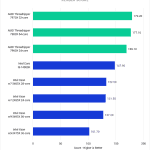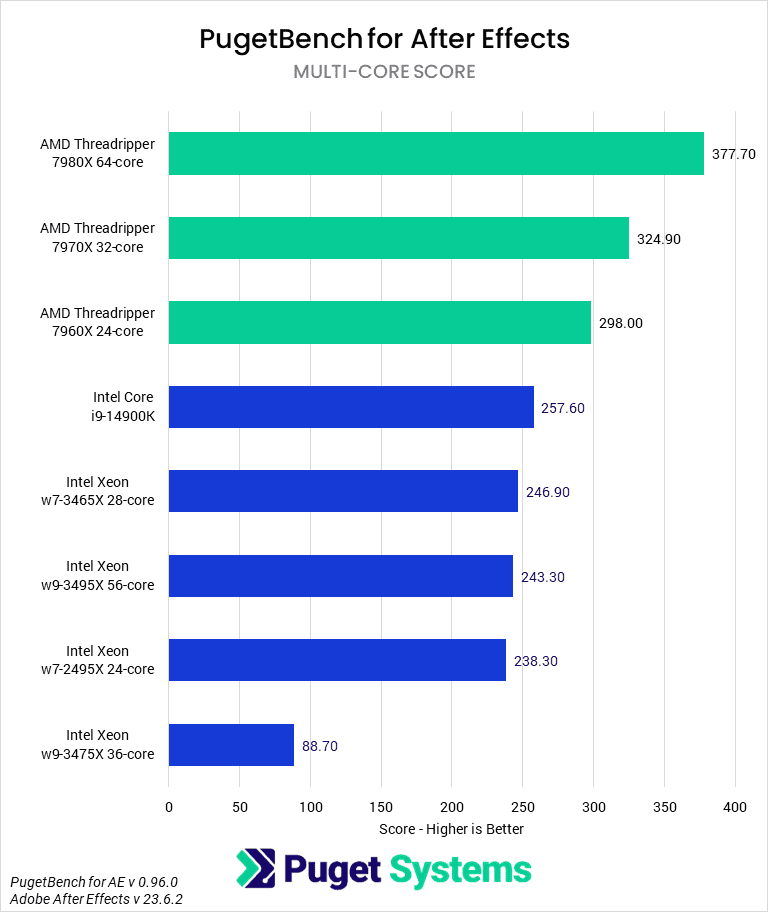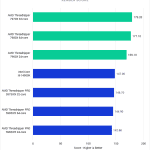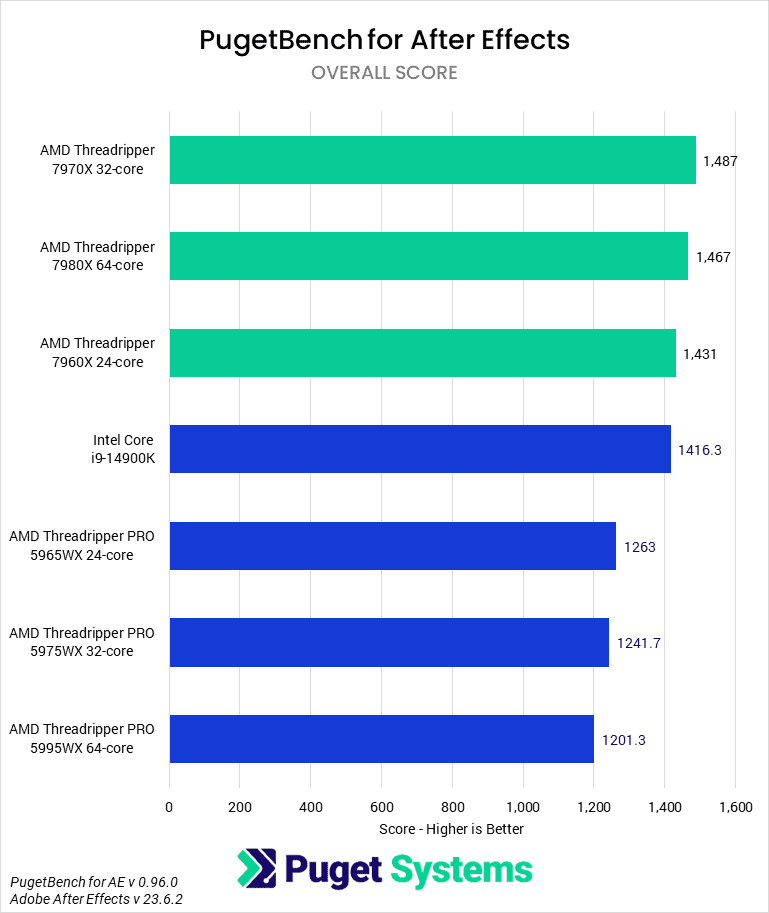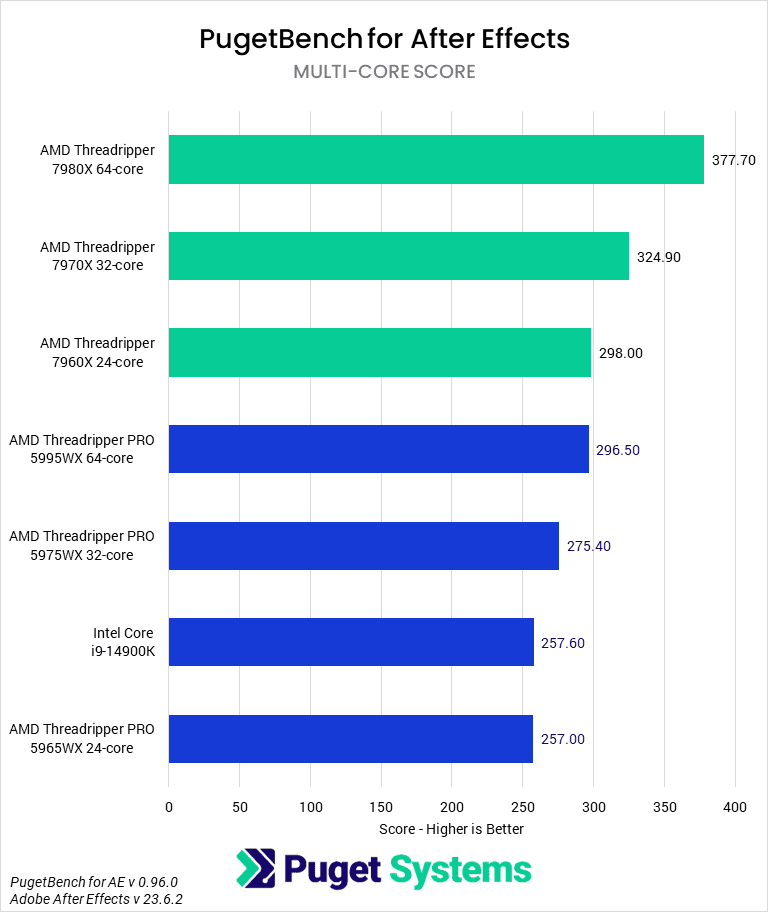Table of Contents
TL;DR: AMD Threadripper 7000 Performance in After Effects
Overall, the new AMD Threadripper 7000 processors do extremely well in After Effects, offering a gen-to-gen performance gain of 15-20% over the AMD Threadripper PRO 5000 WX-series. Since the Threadripper 7000 processors are also anywhere from $650 to $1,000 less expensive than the previous generation Threadripper PRO models, that gives them an even larger performance increase relative to their cost.
This increase in performance allows AMD to take a healthy lead over Intel’s Xeon W-2400/3400 line, performing on average about 25-40% faster at similar price points.
Introduction
With the new Threadripper and Threadripper PRO CPUs, AMD is once again splitting their high core-count CPUs into two separate product families: the High-End Desktop (HEDT) AMD Ryzen Threadripper 7000 Series, and the even higher tier AMD Ryzen Threadripper PRO 7000 WX-Series processors. Both are based on AMD’s Zen 4 architecture, which means they now support new technologies like PCI-e Gen 5.0 and DDR5 memory, but we also expect an increase in both per-core and multi-core performance.
The big difference between the Threadripper and Threadripper PRO families is that Threadripper PRO offers more memory channels, additional PCIe lanes, and a 96-core processor that isn’t available from the Threadripper line. While these may have some benefits for After Effects, we suspect that in most cases, they will not be enough to justify the much higher cost.
Today, we will focus on the performance of the Threadripper 7000 Series (non-PRO) compared to the previous generation Threadripper PRO 5000WX and the Intel Xeon W-2400/3400 line. In our last Intel Xeon W-3400 review, we found that the Threadripper PRO 5000 Series CPUs traded blows with the new Xeon chips, so we suspect that the new Threadrippers will be able to propel AMD in front. In addition to Threadripper PRO and Xeon, we will also include the Intel Core 14900K to provide some context for how AMD Threadripper compares to a more typical CPU choice for this type of workload.
Because there are so many CPUs to examine, we will break our analysis down into Intel vs AMD (AMD Threadripper 7000 vs Intel Xeon W-3400) and performance versus the previous generation (AMD Threadripper 7000 vs AMD Threadripper PRO 5000WX)
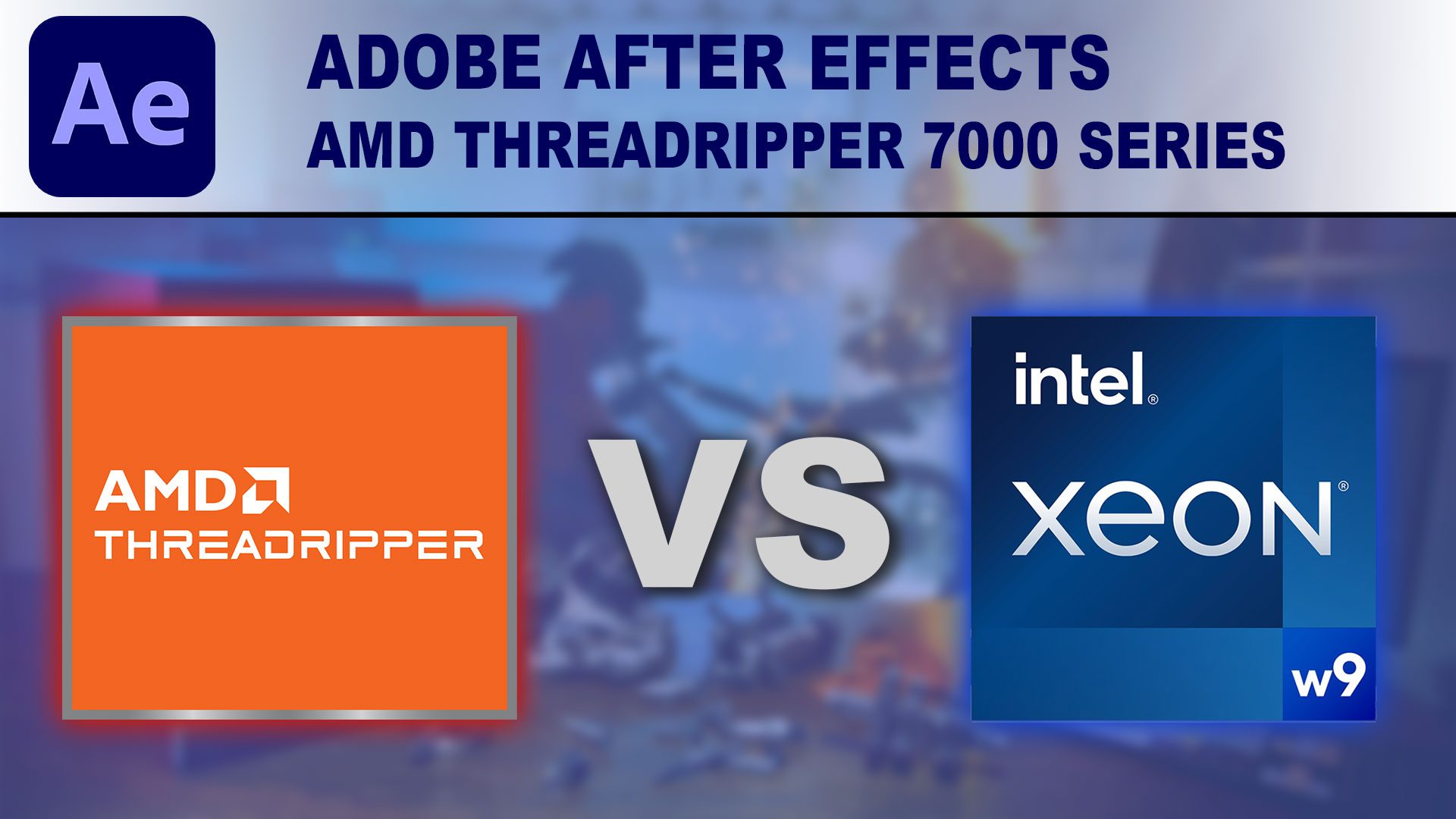
To learn more about how the new AMD Ryzen Threadripper 7000 Series processors perform in other workflows, we have compiled an overview in our AMD Ryzen Threadripper 7000 Content Creation Review article. That post also includes more detailed information on the CPU specifications and test results for various applications: Photoshop, Premiere Pro, DaVinci Resolve, After Effects, Unreal Engine, Cinema 4D, Blender, and V-Ray.
In addition, although all the new AMD CPUs have a TDP of 350 W, TDP is rarely the whole story. To see how much power these chips use to complete tasks, check out our Power Analysis: AMD Ryzen Threadripper 7000 article.
Raw Benchmark Data
We design our benchmarks to cover a large swathe of workflows and tasks to provide a balanced look at the application and its hardware interactions. However, many users have more specialized workflows. Recognizing this, we like to provide individual results for benchmarks as well. If there is a specific area that comprises most of your work, examining those results will give a more accurate understanding of the performance disparities between components.

AMD Threadripper 7000 vs Intel Xeon W-3400 for Adobe After Effects
After Effects has several different aspects and workflows that dictate how it uses the hardware in your system. It is CPU-bound in most cases, but whether it works best on a CPU with high per-core performance, a high number of cores, or a combination of the two depends on what you are doing.
Our benchmarks break up these workloads into various scores to try to give you an idea of how each CPU could perform for you. For most people, the Overall Score (chart #1) will be the best single number to look at, as it covers a wide range of projects. We will note that since a large portion of After Effects is only lightly threaded, the difference between CPUs of the same family tends to be relatively small. That doesn’t mean that the higher-end Threadripper CPUs can’t be worth it, but it will typically only come into play for extremely complex projects that can best take advantage of the multi-frame rendering feature. For this type of workload, the Multi-Core Score (chart #2) is the better metric to use.
With that explained, we can take a look at how the new AMD Threadripper 7000 series compares to the Intel Xeon W-2400/3400 line. Right away, you can tell that AMD comes out very favorably, and when we break it down, it is a very clear win for AMD.
Starting with the AMD Threadripper 7960X 24-core, the closest Intel CPU in price we tested was the Xeon w7-2495X 24-core, although it is actually closer in price to the 7970X 32-core. Still, it is a core-to-core comparison, and even with the Intel CPU being more expensive, the 7960X comes out on top by about 26% overall. There are variations if you look at the individual score, but this should accurately represent most After Effects workloads.
Moving up a step to the Threadripper 7970X 32-core, the Xeon w7-2495X 24-core is again the closest price comparison from Intel. Between these two CPUs, the 7970X is about 31% faster overall, and for heavy projects that typically justify using this class of CPU, the performance lead increases to 36%.
At the top of the stack, the Threadripper 7980X 64-core is a bit hard to compare because its price falls right in between the Xeon w9-3475X 36-core and the w9-3495X 56-core. However, the w9-3475X gave us some odd results for the Multi-Core score in particular – likely due to ongoing performance oddities we often see with Adobe applications when Windows starts to use multiple logical processor groups. Even if we ignore that result and compare only to the more expensive w9-3495X 56-core, AMD still comes out well on top, scoring 40% higher overall, or 55% higher for the Multi-Core score in particular.
AMD Threadripper 7000 vs AMD Threadripper PRO 5000WX for Adobe After Effects
As we showed in the previous section, AMD has a winner with the new Threadripper 7000 processors, giving them a 25-40% performance lead over the competition. The reason behind this is clear when we look at the gen-over-gen performance, where the new CPUs came in at around 15-20% faster than the Threadripper PRO 5000 WX-series, or up to 27% faster for especially heavy projects.
This performance gain is even enough to put Threadripper slightly above the Intel Core i9-14900K overall, although only by a few percent. Threadripper 7000 can be a larger 10-30% faster for heavy projects, but it is worth keeping in mind that the higher per-core performance of the 14900K makes it slightly faster for RAM Preview of more standard After Effects projects or specific tasks like tracking.
How Well Do the AMD Threadripper 7000 CPUs Perform in After Effects?
Overall, the new AMD Threadripper 7000 processors do extremely well in After Effects, offering a gen-to-gen performance gain of 15-20% over the AMD Threadripper PRO 5000 WX-series. Since the Threadripper 7000 processors are also anywhere from $650 to $1,000 less expensive than the previous generation Threadripper PRO models, that gives them an even larger performance increase relative to their cost.
This increase in performance allows AMD to take a healthy lead over Intel’s Xeon W-2400/3400 line, performing on average about 25-40% faster at similar price points.
While we still need to test the AMD Threadripper PRO 7000 CPUs to see if they can give any additional performance advantages, the Threadripper 7000 processors are looking like they are the best option currently available for After Effects users who are working with extremely complex projects or need more than the 128GB of RAM that is typically possible on a consumer-based CPU like Intel Core or AMD Ryzen.
Every application uniquely utilizes hardware, so our results here don’t necessarily translate to any other application. Our focus in this article centers specifically on Threadripper 7000’s performance in Adobe After Effects. However, we recommend checking out our AMD Ryzen Threadripper 7000 Content Creation Review article, which includes a broad overview of results for several different applications. If you use other software packages, it also has links to our in-depth testing articles for content creation: Photoshop, Lightroom Classic, Premiere Pro, DaVinci Resolve, Unreal Engine, Cinema 4D, Blender, and V-Ray.
Finding the perfect workstation doesn’t have to be complicated. Explore our solutions page for a curated selection of recommended systems for a multitude of applications and workflows, or visit our custom configuration page if you already know the ideal hardware for your needs. If you need assistance with tailoring a system to a unique workflow or have any other questions, we encourage you to reach out to our dedicated technology consultants.




